#heliothraupis
Text

ITS TIME
FOR
DINOSAUR MARCH MADNESS 2k23!!!!!!!!!!!!
Starting NEXT WEEK, we begin the ultimate competition:
DMM: RISING STARS
These are ALL dinosaurs that have been discovered in the past five years!!! New friends from old times!!! Including such new fan favorites as Bajadasaurus, Jakapil, Meraxes, and Anachronornis - and that's only four of them!
From the weird to the wonderful, these dinosaurs are here to indicate that just because they were found recently, doesn't mean that they aren't destined to become icons like the names we already know and love. Get ready to learn about some new paleontological excitement - and debate angrily over which ones are better ;)
Round One will go from March 1st through the 7th
Round Two will extend from March 8th through the 14th
Round Three will then go from the 15th to the 21st
Round Four from the 22nd to the 28th
And the FINAL FOUR SHOWDOWN (Ornithischian Vs Sauropodomorph vs Nonavian theropod vs Bird) will occur from March 29th through April 4th!
Thanks to the new tumblr poll feature, reconstructions and mini factfiles for each dinosaur will be on the post with the poll itself! No need to leave tumblr, no personal research, no google quizzes - just rapid learning and immediate voting!
Get ready to vote! Get ready to debate! Get ready... for DINOSAUR MARCH MADNESS!
Round One Matchups under the readmore :)
SAUROPODOMORPHA (and miscellany)
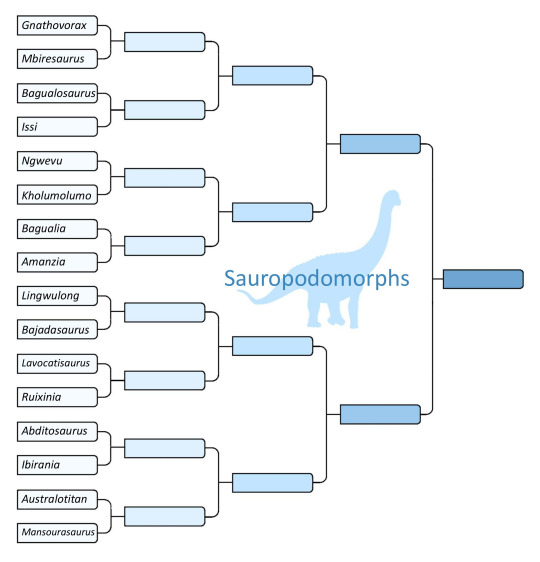
Gnathovorax vs Mbiresaurus
Bagualosaurus vs Issi
Ngwevu vs Kholumolumo
Bagualia vs Amanzia
Lingwulong vs Bajadasaurus
Lavocatisaurus vs Ruixinia
Abditosaurus vs Ibirania
Australotitan vs Mansourasaurus
ORNITHISCHIA
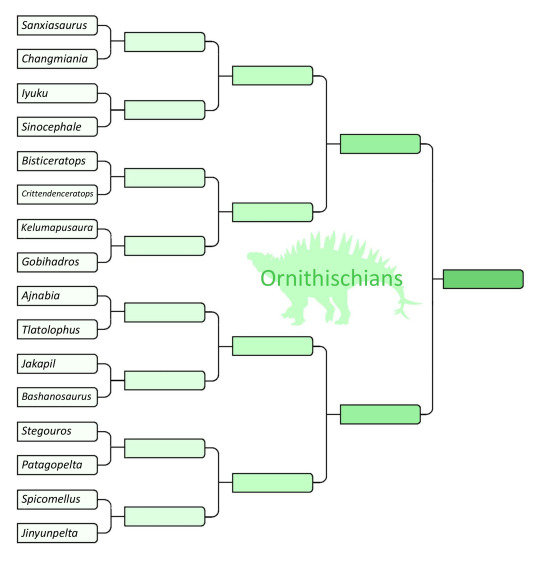
Sanxiasaurus vs Changmiania
Iyuku vs Sinocephale
Bisticeratops vs Crittendenceratops
Kelumapusaura vs Gobihadros
Ajnabia vs Tlatolophus
Jakapil vs Bashanosaurus
Stegouros vs Patagopelta
Spicomellus vs Jinyunpelta
NONAVIAN THEROPODA
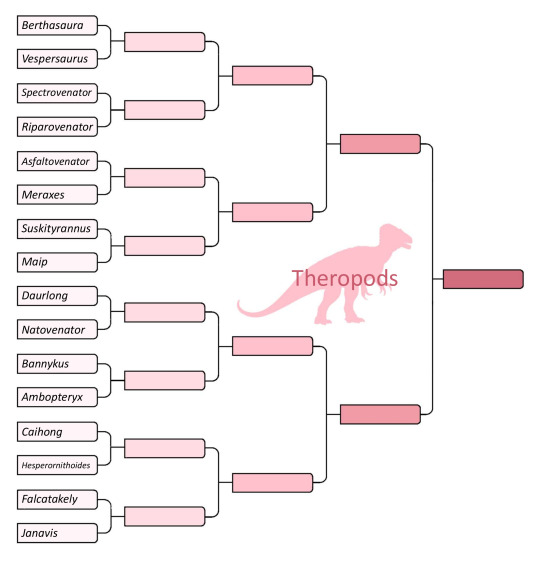
Berthasaura vs Vespersaurus
Spectrovenator vs Riparovenator
Asfaltovenator vs Meraxes
Suskityrannus vs Maip
Daurlong vs Natovenator
Bannykus vs Ambopteryx
Caihong vs Hesperornithoides
Falcatakely vs Janavis
NEORNITHES (BIRDS)

Vorombe vs Prodontopteryx
Asteriornis vs Panraogallus
Anachronornis vs Conflicto
Annakacygna vs Nasidytes
Aviraptor vs Cryptogyps
Miosurnia vs Primoptynx
Danielsraptor vs Heracles
Eofringillirostrum vs Heliothraupis
#dinosaur march madness#dmm#dmm rising stars#palaeoblr#dinosaurs#bracket#polls#march madness#tumblr dinosaur competition#thank you tumblr for making polls dmm is so much easier now I will cry#heliothraupis#eofringillirostrum#heracles#danielsraptor#primoptynx#miosurnia#cryptogyps#aviraptor#nasidytes#annakacygna#conflicto#anachronornis#panraogallus#asteriornis#prodontopteryx#vorombe#janavis#falcatakely#hesperornithoides#caihong
835 notes
·
View notes
Photo

A new variant has been added!
Inti Tanager (Heliothraupis oneilli)
© abcdefgewing
It hatches from , and undefined eggs.
squawkoverflow - the ultimate bird collecting game
🥚 hatch ❤️ collect 🤝 connect
2 notes
·
View notes
Text
Heliothraupis oneilli Lane et al., 2021 (new genus and species)

(Illustration of male [above] and female [below] individuals of Heliothraupis oneilli by Daniel F. Lane, from Lane et al., 2021)
Meaning of name: Heliothraupis = sun small bird; oneilli = for John P. O'Neill [American ornithologist]
Suggested common name: Inti tanager
Age: Holocene (Meghalayan), extant
Where found: Forests and woodlands in Cusco, Peru and the Machariapo Valley, La Paz, Bolivia
How much is known: At least 17 collected specimens (16 males and one female) are held in museum collections.
Notes: Heliothraupis is a tanager, an extremely diverse group of songbirds from the American tropics. There are over 380 species of tanager known, and many of them are difficult to tell apart. Male individuals of Heliothraupis, however, are easily recognizable, with an orange head crest, a dark streak above each eye, and a bright yellow face and underside. Their yellow and black color scheme bears some resemblance to orioles of the genus Oriolus (which are not closely related to tanagers). Female Heliothraupis, on the other hand, have a brownish band across their chest and a mostly olive head, and they lack a head crest.
Despite being brightly colored, Heliothraupis is rarely seen, as it appears to spend most of its time hidden in dense vegetation. The oldest verified sighting of one dates to 1993, and the species was not recognized as potentially new to science until the early 2000s. If not for the loud and distinctive song of the male, it is likely that it would be even less frequently recorded.
Based on the relatively few observations that have been made so far, Heliothraupis probably breeds in the Machariapo Valley of western Bolivia, but spends its non-breeding season along the lower slopes of the Andes in southeastern Peru. This type of migratory behavior is uncommon among tanagers. In both its breeding and non-breeding range, Heliothraupis appears to prefer habitats dominated by bamboo and similar plants. Examination of stomach contents and behavioral observations suggest that it feeds mostly on insects and occasionally on fruits.
The closest living relative of Heliothraupis seems to be the black-goggled tanager (Trichothraupis melanops). Given that these two species look very different from one another, the describers of Heliothraupis chose to gave it a new genus instead of classifying it in the same genus as T. melanops.
Prior to being scientifically described, Heliothraupis was known by several nicknames in the birding community, including “San Pedro tanager”, “Manu Road tanager”, and “Kill Bill tanager”. The authors’ proposed common name, “inti tanager”, is derived from the Quechua and Aymara words for “sun”, referencing the bird’s bright yellow plumage.
Reference: Lane, D.F., M.A. Aponte Justiniano, R.S. Terrill, F.E. Rheindt, L.B. Klicka, G.H. Rosenberg, C.J. Schmitt, and K.J. Burns. 2021. A new genus and species of tanager (Passeriformes, Thraupidae) from the lower Yungas of western Bolivia and southern Peru. Ornithology advance online publication. doi: 10.1093/ornithology/ukab059
49 notes
·
View notes
Text
Round Two: Heracles vs Heliothraupis
Heracles inexpectatus
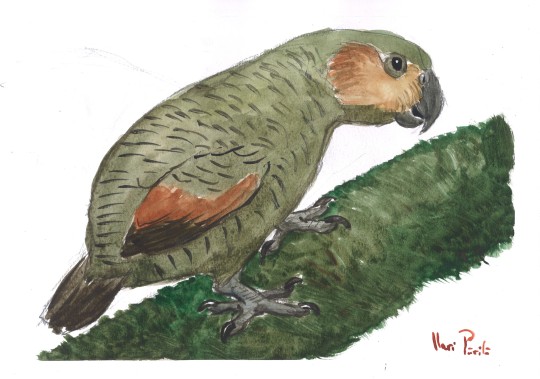
Artwork by @otussketching, written by @zygodactylus
Name Meaning: Unexpected Herculean Parrot
Time: 16 to 19 million years ago (Burdigalian stage of the Miocene epoch, Neogene period)
Location: St. Bathans Fauna, Bannockburn Formation, Aotearoa
Heracles was a truly alarmingly large parrot, related to modern day Kea, Kaka, and Kakapo, known from the fantastic avifauna of St Bathans. Standing more than two feet tall and weighing about fifteen pounds, this animal was much larger than any expected from the St Bathans fauna, which represented the initial colonization of Aotearoa (Zealandia) after it returned above sea level. Heracles is also the largest known species of parrot, ever. It was presumably flightless, though it is uncertain if it was nocturnal like its living relative the Kakapo. Its exact ecology is still uncertain, given the material known from Heracles is limited and its living relatives have very disparate ecologies, though it is possible it was omnivorous similar to the Kea and Kaka today. The St Bathans fauna lived in a freshwater lake system, in a subtropical emergent rainforest. Separated from land bridges, the fauna was dominated by birds, with early relatives of the Kiwi, New Zealand Wrens, Adzebills, and Wedge-Tailed eagles found in the fauna, as well as somewhat modern looking Moas. Smaller flamingos, large fruit pigeons, and a huge variety of geese and other waterfowl are known. In addition, frogs, tuataras, other lizards, crocodilians, turtles, and many different types of fish are known from this fascinating ecosystem.
Heliothraupis oneilli
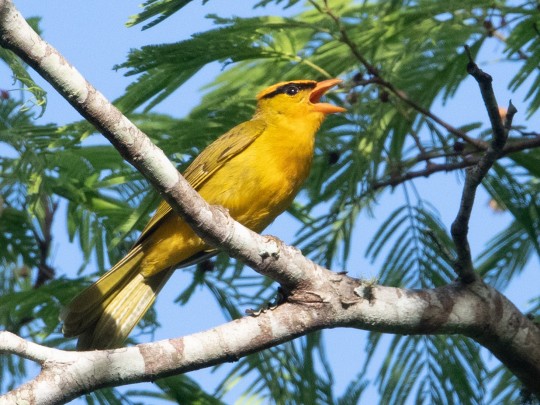
Photograph by John C. Mittermeier, written by @zygodactylus
Name Meaning: O’Neill’s Tanager of the Sun God Inti
Time: Unknown to the present, Holocene, Quaternary
Location: Western Bolivia and Southern Peru, South America
Rarely do we get to talk about a newly discovered living species of bird, but this is one of those excellent times! This bird, a bright yellow tanager with a distinctive black stripe across its eye, was found in the Neotropics - specifically in the Yungas region. Given that Latin America has the largest number of bird species in the world, it makes a certain amount of sense that we may have missed some! First spotted in the nineties, it was properly identified and described over the course of the 2010s. The distinctive appearance of this tanager lead to it being nicknamed the “Kill Bill Tanager”, in reference to its similarity to Uma Thurman’s yellow jumpsuit outfit. Distinct in appearance and population from other tanagers, it was deemed not only a separate species, but an entirely separate genus. It is migratory, breeding in the northern Machariapo Valley and going down to the eastern Andes for the nonbreeding season. It lives in deciduous forests, and breeds in bamboo grasses. It is a loud and vocal bird, making distinctive songs and choruses that happen long after the dawn chorus of most other birds. As it lives in a fairly isolated region of these countries, its habitat is not particularly threatened at this time.
#dmm rising stars#dmm#dinosaur march madness#dinosaurs#palaeoblr#birds#birblr#paleontology#bracket#march madness#polls#heracles#heliothraupis#round two
247 notes
·
View notes
Text
Eofringillirostrum vs Heliothraupis
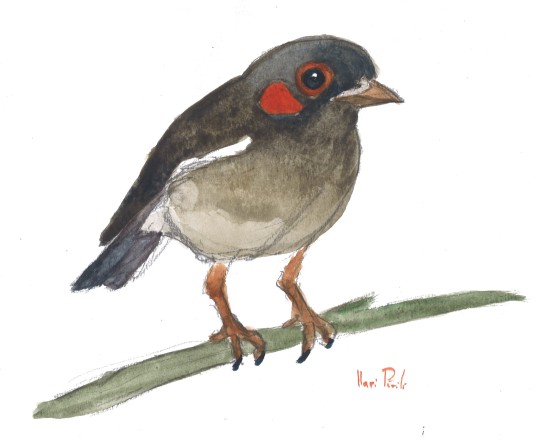
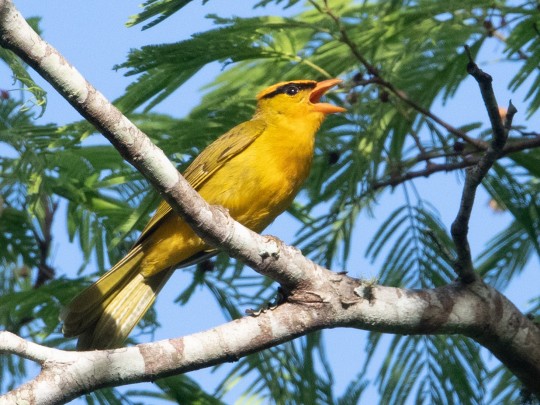
Factfiles:
Eofringillirostrum boudreauxi, E. parvulum

Artwork by @otussketching, written by @zygodactylus
Name Meaning: Dawn Finch-Beak (Boudreaux’s or Small)
Time: 54 to 48 million years ago, in the Ypresian of the Eocene
Location: Sandwich Beds, Fossil Butte Member, Green River Formation, Wyoming; and the Messel Formation near Darmstadt, Germany
Today, over half of the birds known in the world are passerines, or “perching birds”. Unfortunately, these birds on average are small and delicate, leading to their not having the most robust fossil record compared to other birds. However, the fossils of passerines we do have tell us an interesting story about their evolution. Eofringillirostrum, despite being a very early member of the total-passeriform group (ie, it isn’t a true passerine, but close), shows how many of the traits we see in modern representatives occurred fairly early on in their evolution. Eofringillirostrum had a finch-like beak, similar to living species, that would have been helpful in eating small hard seeds - a niche not easily exploited. While we often think of birds as “seed-eaters”, this is not common and only exploitable by certain species - and, apparently, some early passerine relatives like Eofringillirostrum. This indicates that different early relatives of passerines were already doing very similar ecological jobs to their living relatives, even while many other bird types were exploiting passerine-like niches (such as the many types of stem-mouse birds that lived at the time). Both the Messel Pit and the Fossil Butte environments were tropical forests, emerging right after the Paleocene-Eocene Thermal Maximum; both were associated with fossil lakes, which allowed for rapid preservation of a variety of early animals that show how “modern” life first diversified in the Paleogene period. As such, Eofringillirostrum just has too many neighbors to list - including so many kinds of birds its a little overwhelming. Eofringillirostrum, in this environment, would have been one of many different species of birds, and weirdly modern looking among them!
Heliothraupis oneilli

Photograph by John C. Mittermeier, written by @zygodactylus
Name Meaning: O’Neill’s Tanager of the Sun God Inti
Time: Unknown to the present, Holocene, Quaternary
Location: Western Bolivia and Southern Peru, South America
Rarely do we get to talk about a newly discovered living species of bird, but this is one of those excellent times! This bird, a bright yellow tanager with a distinctive black stripe across its eye, was found in the Neotropics - specifically in the Yungas region. Given that Latin America has the largest number of bird species in the world, it makes a certain amount of sense that we may have missed some! First spotted in the nineties, it was properly identified and described over the course of the 2010s. The distinctive appearance of this tanager lead to it being nicknamed the “Kill Bill Tanager”, in reference to its similarity to Uma Thurman’s yellow jumpsuit outfit. Distinct in appearance and population from other tanagers, it was deemed not only a separate species, but an entirely separate genus. It is migratory, breeding in the northern Machariapo Valley and going down to the eastern Andes for the nonbreeding season. It lives in deciduous forests, and breeds in bamboo grasses. It is a loud and vocal bird, making distinctive songs and choruses that happen long after the dawn chorus of most other birds. As it lives in a fairly isolated region of these countries, its habitat is not particularly threatened at this time.
DMM Round One Masterpost
#dmm#dinosaur march madness#dinosaurs#birds#dmm round one#dmm rising stars#birblr#palaeoblr#paleontology#bracket#march madness#polls#eofringillirostrum#heliothraupis
161 notes
·
View notes
Text
DMM ROUND TWO MASTERPOST
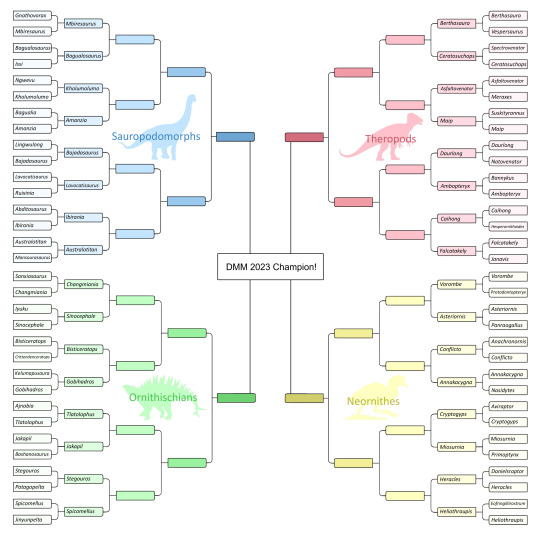
Ornithischians
Changmiania vs Sinocephale
Bisticeratops vs Gobihadros
Tlatolophus vs Jakapil
Stegouros vs Spicomellus
Sauropodomorphs
Mbiresaurus vs Bagualosaurus
Kholumalumo vs Amanzia
Bajadasaurus vs Lavocatisaurus
Ibirania vs Australotitan
Nonavian Theropods
Berthasaura vs Ceratosuchops
Asfaltovenator vs Maip
Daurlong vs Ambopteryx
Caihong vs Falcatakely
Avians (Neornithes)
Vorombe vs Asteriornis
Conflicto vs Annakacygna
Cryptogyps vs Miosurnia
Heracles vs Heliothraupis
REBLOG! SHARE! DEBATE!
IT'S DINOSAUR MARCH MADNESS!!!
#dmm#dinosaur march madness#dmm rising stars#dinosaurs#birds#dmm round two#dmm masterpost#paleontology#march madness#bracket#polls#birblr#palaeoblr
405 notes
·
View notes